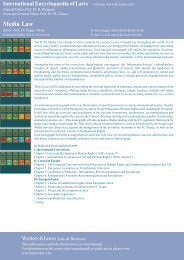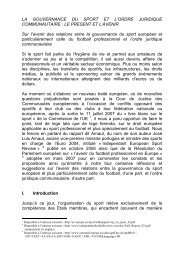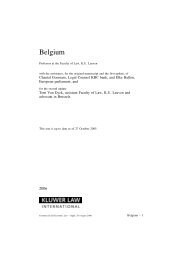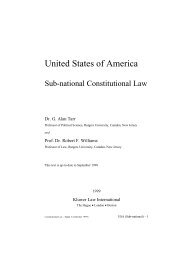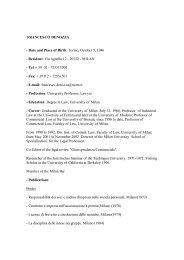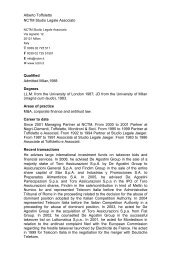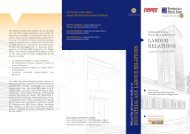Catalogue - International Encyclopaedia of Laws
Catalogue - International Encyclopaedia of Laws
Catalogue - International Encyclopaedia of Laws
Create successful ePaper yourself
Turn your PDF publications into a flip-book with our unique Google optimized e-Paper software.
<strong>International</strong> <strong>Encyclopaedia</strong> <strong>of</strong> <strong>Laws</strong><br />
Social Security Law<br />
Editor: Pr<strong>of</strong>. Dr. Willy van Eeckhoutte E-mail: willy.vaneeckhoutte@bellaw.be<br />
Assistant: Ester Van Oostveldt E-mail: ester.vanoostveldt@bellaw.be<br />
Social security is a major institution <strong>of</strong> all industrialized<br />
societies. Its purpose is to protect the population from serious<br />
health and financial risk; to achieve this goal, social security<br />
law regulates the relations between enterprises and other<br />
economic entities on the one hand, and families and individuals<br />
on the other. This regulation is typically accomplished through<br />
a complex network <strong>of</strong> public and private institutions operating<br />
under national law.<br />
This set in the <strong>International</strong> <strong>Encyclopaedia</strong> <strong>of</strong> <strong>Laws</strong> provides<br />
pr<strong>of</strong>ound information on the different social security schemes<br />
in the various countries. The basic ideas and mechanisms <strong>of</strong><br />
each scheme are described in an easily comprehensible way.<br />
The legal mechanisms <strong>of</strong> the following areas <strong>of</strong> social protection<br />
are covered in each monograph: health care, employment<br />
injuries and occupational diseases, sickness benefits, pensions,<br />
unemployment and family benefits.<br />
Due to the fact that a similar structure <strong>of</strong> text is used for every<br />
country, the main differences between the various national<br />
social security systems is clearly underlined. Law enforcements,<br />
controls and appeals receive special attention.<br />
A group <strong>of</strong> international monographs explains the role <strong>of</strong><br />
international organizations in setting norms for social security<br />
systems and in coordinating existing systems in cases involving<br />
migrant workers and others to whom more than one national<br />
scheme may be applicable. An international social security law<br />
codex provides the main international texts, in English, that<br />
regulate social security. The most relevant cases from the ECJ<br />
are also included<br />
The monograph is regularly updated with experts in the field <strong>of</strong><br />
social security law providing theoretical and practical<br />
information concerning the various systems. The general<br />
background <strong>of</strong> the system is described in order to give the<br />
practitioner or legal scholar the necessary background to<br />
understand the differences between the systems and the<br />
developments and evolutions <strong>of</strong> each social security system.<br />
For each country or organization covered the work provides:<br />
List <strong>of</strong> Abbreviations. Preface. General Introduction. Selected<br />
Bibliography.<br />
40<br />
Part I: The Institutions.<br />
1. Public Institutions.<br />
2. Position and Competence <strong>of</strong> the Public<br />
Institutions.<br />
3. Private Institutions.<br />
Part II: Contribution and Financing.<br />
1. Contribution Regulation for Employees.<br />
2. Contributions for Public Sector Workers.<br />
3. Contributions for the Self-Employed.<br />
4. Other Contributions.<br />
5. Government Funding.<br />
Part III: Health Care.<br />
1. Field <strong>of</strong> Application.<br />
2. Benefits.<br />
3. Conditions.<br />
Part IV: Family Allowances.<br />
1. Field <strong>of</strong> Application.<br />
2. Dependent Children.<br />
3. Amount <strong>of</strong> the Benefit.<br />
4. Payment.<br />
Part V: Incapacity to Work.<br />
1. Field <strong>of</strong> Application.<br />
2. Benefits.<br />
3. Certification <strong>of</strong> Incapacity to Work.<br />
4. Benefits.<br />
5. Conditions.<br />
6. Accumulation Rules.<br />
Part VI: Industrial Accidents and Occupational<br />
Diseases.<br />
1. Field <strong>of</strong> Application.<br />
2. Concept <strong>of</strong> ‘Industrial Accident’.<br />
3. Concept <strong>of</strong> ‘Occupational Disease’.<br />
4. Medical Care.<br />
5. Incapacity to Work.<br />
6. Death.<br />
7. Prevention <strong>of</strong> Occupational Diseases.<br />
8. Supplementary Benefits.<br />
9. No-Fault Insurance.<br />
10. Civil Liability.<br />
11. Accumulation Rules.<br />
Part VII: Unemployment.<br />
1. Provision <strong>of</strong> Work.<br />
2. Unemployment Benefit.




